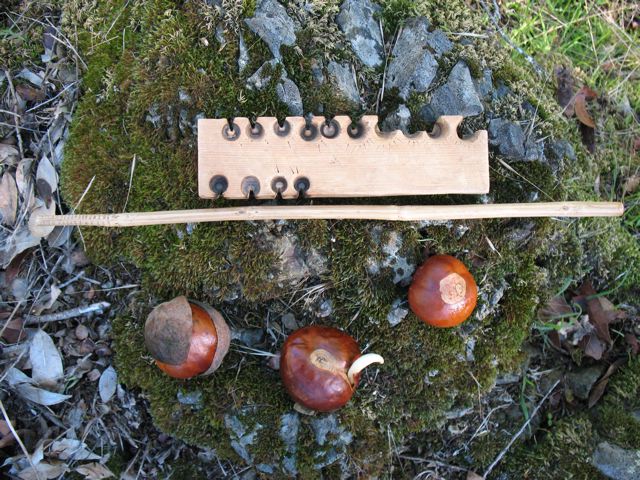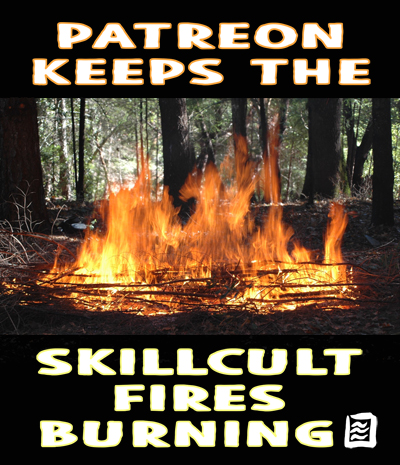The California Buckeye, Aesculus Californica is a tree common to much of California. It has various alleged medicinal uses and the nuts are edible after thorough leaching, though poisonous when fresh. It also has traditional utilitarian uses like fish poison and fire making. It is probably my overall favorite wood for making the drill portion of hand drill fire making kits, and the brittle dead dry branches are useful as kindling. We have a fair number of buckeyes here, but many are old and I've seen a several old trees keel over in the few years I've been here. Although I've had mixed results (mostly not so great) in preparing buckeye as food (something I plan to work on), I'm still very interested in having more of them around as an emergency food source. They are also a good candidate for erosion control projects and this land, due to poor logging, road building, road maintenance and grazing practices, has significant erosion damage which is ongoing. Besides, I like the trees. They look cool, the flowers are pretty, and the seeds look neat and are fun to throw at things. Some wild animals eat them too, though it's hard to imagine how they choke them down since they smell like toxic cat piss. The nectar is supposed to be poisonous to bees, but I'm not about to let that worry me even though I have had bees and plan to have them again.

I also want to have some Buckeye around for coppicing. Coppicing is the act of cutting down a tree or shrub and allowing it to grow back as a profusion of shoots. A mature buckeye is always contorted with short growth twisting this way and that. In order to get good fire drill material, the plant generally has to be cut down, burned or otherwise damaged. It is harvested every so many years and allowed to grow back again. A short hedge of buckeyes for coppicing, safely fenced from deer, is in the master plan here somewhere.
The seeds fall to the ground in December where they seem to be fairly immune to freezes. The root pokes it's way out of the thin red shell and starts growing it's way down toward the earth. The root is a robust appendage and backed by the massive starchy seed, which is generally bigger than a golf ball, it actually stands a chance of piercing deeply into the earth and growing a tree even when simply dropped on the ground, which is of course how the tree sows them. However it is a crap shoot to be sure and the chances for survival of a given seed dropped on the ground are not all that good. The abundance of buckeye trees in California is testament to the effectiveness of this natural system in the overall picture, but I have my own plans about how many trees I want, and also where I want them! By simply burying the nut in the ground a wee bit the chances of sprouting and emergence of the leaves jump up to probably near 100%. My favorite tool for this is a small one handed pick type of tool that I found in the desert some years ago. I chop into the ground with the blade end, pull back slightly, drop the nut in the depression thus formed, pull the pick out and step on the soil to snuggle the nut in nicely. All of that should take under 10 seconds. If there are any seeds, they are usually abundant and the seeds are tough, so no need to waste time being nice or trying to avoid air pockets... your doing them a favor by crushing them into the soil with your boot. If you want to be sure of a tree in that spot, plant three seeds and pull any extras out in a year or two. I don't recommend planting the trees in pots for a year or buying trees in pots. The tree has deep roots to survive drought and a seed planted in the ground is going to give it the natural deep root system it needs to survive the considerable stresses of surviving California's hot dry summers.
Getting the seed to sprout and the leaves to emerge is only the beginning of the game however, because Deer will eat the hell out of the baby trees and for every year to come as long as they can reach them. The plant, like all trees here, is adapted to this kind of browsing pressure and it's ability to survive this kind of hard use is remarkable. Still, most are not going to make it, and the ones that do will take a long time to get tall enough to outgrow the deer and start thriving instead of just surviving. One strategy is just to plant tons of them and some will eventually make it. Still, survival rates AND growth rates can be greatly increased by offering the seedlings some protection. I use two strategies. One is to protect the tree with a wire cage or tree tube. The wire cage can be pretty simple and narrow, like a tall skinny tube of chicken wire tied off to a single stake. Tree tubes are slightly more convenient, if uglier, and are generally not going to be free. If the tube or cage is 5 plus feet tall, the tree can eventually emerge from it and outgrow the deer. It's not a bad idea to leave them on though as the bucks also like to rub their antlers all over small diameter trees and saplings to remove velvet from their antlers and mark territory during the rut. This won't kill the tree, but it might have to re-sprout and start over from near ground level.
Another strategy for tree protection is to plant seeds in thickets of other plants, or much better in among the branches of fallen trees. When I first moved here there was a huge old madrone fallen that I cleared out of the way. It had been down for some years. Along the trunk of that one tree were numerous small shrubs and trees that had taken root. The area all around was clear of any such growth, but the meager shelter provided by the tree trunk had managed to nurse poison oak, oak, fir, Toyon, and blackcap seedlings. Last year I planted some seeds in among the dead branches of fallen buckeye trees. To protect them further, I collected a few more branches and threw them over and around to create a less penetrable "cage" of sorts. You could even just plant the seeds in the open and pile on a bunch of brush as long as the seedling can get some light to grow. I was just noticing today while thinning and limbing up young fir trees just how often they serve as nurseries for saplings of other species. Fir saplings tend to branch a lot low to the ground creating a protective environment for whatever sprouts up near the trunk. Since birds use the saplings as perches, species like berries that are commonly consumed by birds sprout up from their droppings underneath the tree. Of course the fir sapling also offers fierce competition for light, water and nutrients so the trees growing under their protection are going to tend to spindly-ness. In my case I'm thinning out the firs in favor of hardwoods and once I cut out and limb up the firs, the madrone, bay, various oak species, toyon and poison oak have new opportunity to use their already well established root systems to push up and out away from the browsing pressure of deer. Since I'm continually removing young fir trees to maintain a balance of hardwoods and conifers near the trunk of a fir sapling is a great place to put a buckeye with the plan of removing the fir in the future once the buckeye is established.
If you really wanted the tree to grow fast, you could also mulch around the base with whatever is around to retain moisture and keep other plants for growing around the base and using up resources. But, Buckeye is a super tough tree and that shouldn't be necessary for it's survival.
I've been using most of these strategies. Plant a ton of them since it's easy enough, protect a few with cages or tubes where I really want them to grow the most, and bury some seeds in and around fallen trees and logs where they will have a better chance of survival.




